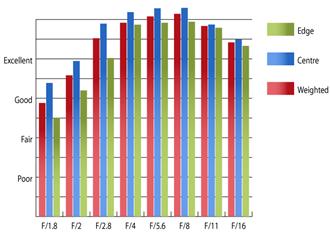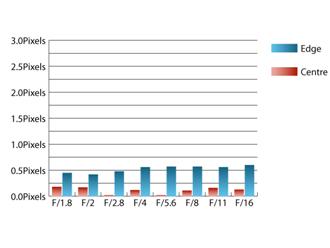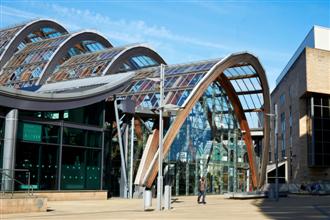Nikon AF-S Nikkor 50mm f/1.8G
Nikon AF-S Nikkor 50mm f/1.8G Performance
Even when shooting wide open at f/1.8, the clarity in the central portion of the frame is very good, although the quality towards the edges of the frame is fairly good.
As with most lenses, stopping down the aperture increases this optics performance across the frame and by f/2 the lens produces images with good sharpness from edge to edge with near excellent clarity in the centre. Peak performance is achieved between f/5.6 and f/8, where this lens' performance is truly outstanding across the frame.
Resolution at 50mm | How to read our charts |
 | The blue column represents readings from the centre of the picture frame at the various apertures and the green is from the edges. Averaging them out gives the red weighted column. The scale on the left side is an indication of actual image resolution. The taller the column, the better the lens performance. Simple. For this review, the lens was tested on a Nikon D700 using Imatest. |
The simple optical design requires no exotic ED glass to keep chromatic aberrations under control. At its worst, fringing chromatic fringing covers and area that just exceeds 0.5 pixel widths, which should pose few issues, even in very large prints or harsh crops from the edge of the frame.
Chromatic Aberrations at 50mm | How to read our charts |
 | Chromatic aberration is the lens' inability to focus on the sensor or film all colours of visible light at the same point. Severe chromatic aberration gives a noticeable fringing or a halo effect around sharp edges within the picture. It can be cured in software. Apochromatic lenses have special lens elements (aspheric, extra-low dispersion etc) to minimize the problem, hence they usually cost more. For this review, the lens was tested on a Nikon D700 using Imatest. |
Falloff of illumination towards the corners is quite pronounced on FX format cameras at f/1.8. Here the corners of the frame are 2.5 stops darker than the image centre, which can be a blessing, or a curse depending on your preference. Stopping the lens down results in more even illumination across the frame and visually uniform illumination is achieved at f/4.
For a prime lens like this, barrel distortion is quite pronounced, which may pose problems for critical applications such as copy stand work. Imatest detected 1.98 barrel distortion and the pattern of distortion is uniform across the frame, which should make it relatively easy to correct in image editing software afterwards.
The deeply recessed front element is already well protected from extraneous light that may cause flare or loss of contrast and a deep circular hood is also provided to provide further protection. When shooting into the light, the simple optical design ensures this lens maintain good contrast and is resistant to flare in all but the most extreme of conditions.
Add your message
Login required
Please login here or if you've not registered, you can register here. Registering is safe, quick and free.
Please login here or if you've not registered, you can register here. Registering is safe, quick and free.
photodo Stats
1102 lenses
428 MTF tests
74 in-depth photodo reviews
100+ users join each day
Help the lens community by reviewing or rating a lens today via our lens search
428 MTF tests
74 in-depth photodo reviews
100+ users join each day
Help the lens community by reviewing or rating a lens today via our lens search
Latest Lens Reviews
- Chinon 28mm f/2.8 Vintage Lens Review
- Canon EF 70-200mm f/4L IS II USM Lens Review
- Samyang AF 85mm f/1.4 EF Review
- Sigma 70mm f/2.8 DG Macro Art Review
- Samyang AF 24mm f/2.8 FE Review
- Meike 50mm f/1.7 Review
- Tamron 70-210mm f/4 Di VC USD Review
- Lensbaby Burnside 35mm f/2.8 Review
- Asahi Super Takumar 50mm f/1.4 Review
- Asahi Super-Multi-Coated Takumar 135mm f/3.5 Review






